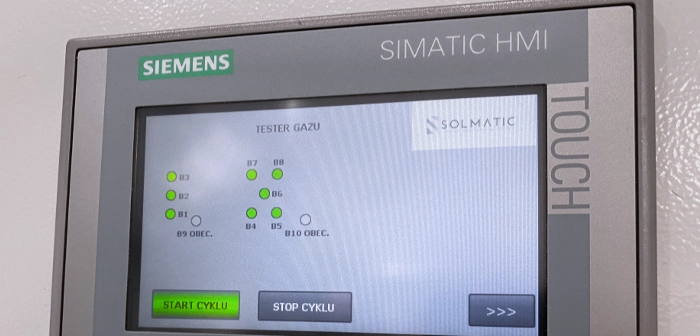
Prototype Can Leak Tester – An Innovative Approach to Aerosol Testing
For our client, a leading company in the field of gas fuels for lighters and camping gas cartridges, the Solmatic team delivered a prototype can leak tester based on innovative gas leak detection technology using semiconductor sensors. This project responds to the growing demand for efficient, alternative leak testing methods that meet strict industry standards.
Project date: Q2, 2021
Challenge
In aerosol production, one of the key challenges manufacturers face is can leakage. Leaks can result from manufacturing defects in the cans themselves or from damaged valves that release gas under internal pressure. Gas under high pressure may escape through microcracks or improperly sealed valves, leading to leaks and, in extreme cases, explosions. To minimize this risk, it is crucial to use only the highest quality components from reputable suppliers.
But that’s not all. In aerosol manufacturing, precisely adjusting valve crimping parameters to match each can is also critically important. At first glance, many cans may look alike, but they differ in key details such as material thickness or structural microdeformations. Each can type may therefore require different machine settings. These parameters are typically recommended by can or valve manufacturers. However, even when using top-quality components, variation can still occur. This makes it essential to use equipment that offers the highest precision and consistent leak control.
Traditionally, the aerosol industry uses waterbath testers as the main method for leak detection. These baths operate by immersing cans in hot water at around 60°C for several minutes. If a can is leaking, the internal gas pressure causes it to explode in this controlled environment. This method is widely accepted by industry regulations and meets strict safety standards defined by international directives. However, waterbath testers are expensive to purchase and maintain, and highly energy-consuming — which is increasingly problematic in the context of growing environmental awareness and the need to reduce operational costs.
Our client, a leader in gas fuel for lighters and cartridges, was looking for an alternative. The main goal was to design equipment that would be just as reliable as a waterbath tester, but cheaper to maintain and more energy-efficient. We aimed to develop a solution that could be easily integrated into the existing production line while providing the highest leak detection accuracy. The ultimate goal was to deliver a technology that meets the requirements for alternative leak testing methods without compromising on safety or precision.
In response to these challenges, we developed a prototype can leak tester based on advanced semiconductor sensors. This modern device detects potential gas leaks with great precision thanks to ultra-sensitive sensors. Compared to traditional methods, our prototype is more energy-efficient, more economical, and more adaptable to different production line capacities.
Our Approach
Our goal was to design a modular leak testing system that could serve as an alternative to traditional waterbath testers while meeting stringent safety standards. During the development of this solution, we paid special attention to compliance with ATEX directives and guidelines for alternative leak testing methods.
We used semiconductor sensors, which, thanks to their sensitivity, enable the detection of even the smallest gas leaks. To further enhance measurement accuracy, the device was equipped with two testing stations with different sensitivity levels, allowing even more effective leak detection.
Research and Testing
We began the project with an in-depth analysis of available solutions and industry requirements. While existing technologies are effective, their cost and energy consumption present significant challenges. Our sensor-based solution underwent extensive testing, confirming its efficiency in detecting leaks. The sensors were tested under conditions replicating those of the client’s production lines.
Key Technological Features:
- Semiconductor Leak Detection Sensors: The use of ultra-sensitive sensors allows for the detection of even the tiniest gas leaks.
- Modular Design: The device was designed to be easily adaptable to various production lines with capacities ranging from 60 to 120 units per minute.
- Integrated Control System: The built-in control system allows precise adjustment of operating parameters, ensuring maximum effectiveness and safety of the testing process.
Results:
The delivered device was installed on the client’s existing production line, operating in parallel with the waterbath tester. After several months of use, it was confirmed that the prototype leak tester is at least as effective as the standard waterbath while being significantly cheaper to maintain.
Summary of benefits:
- Lower operating costs: Compared to conventional waterbath testers, our device is more energy-efficient and less expensive to maintain.
- High detection precision: The semiconductor sensors used detect even the smallest gas leaks, resulting in higher testing effectiveness.
- Flexibility: The modular design allows easy integration into production lines with varying capacities — from 60 to 120 units per minute.
- Gas Leak Detection Station




